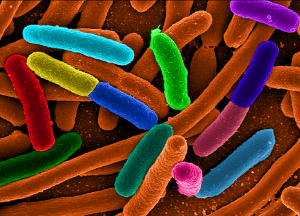FRIDAY, 23 DECEMBER 2011
Certain biofuel syntheses involve the use of metabolic engineering to design organisms that can digest biomatter. The advantage of this technique over bio-ethanol production, for example, is that it produces fuels that are compatible with existing engines and infrastructures. Abundant crops such as switchgrass and agricultural waste provide the raw material, lignocellulose.Before the lignocellulose can be used, however, it must first be converted into simple sugars via the addition of large quantities of an enzyme. The sugars are then treated with another enzyme to yield the biofuel. This two-step process makes this route to biofuels costly and unappealing.
Hoping to address these drawbacks, the researchers at JBEI used what is known as consolidated bioprocessing. They engineered a single form of E. coli that could both degrade the biomass and synthesise the biofuel in a one-step process.
The lab demonstrated that not only could E. coli be engineered to break down the cellulose component to sugars, they could also be designed to express any one of three biofuel-producing pathways. Hence, in one operation, biofuels suitable for use in gasoline, diesel and jet fuel engines could be generated directly from pretreated switchgrass.
While the group acknowledges that further improvement is necessary before this method can be used on an industrial scale, the benefits are clear. The approach could be modified to use other microorganisms and is appropriate for use with many crops worldwide. This encouraging example of consolidated bioprocessing could lead to cost-efficient biofuel synthesis, and help to realise the potential of renewable fuels.
Written by Ruth E. Gilligan

